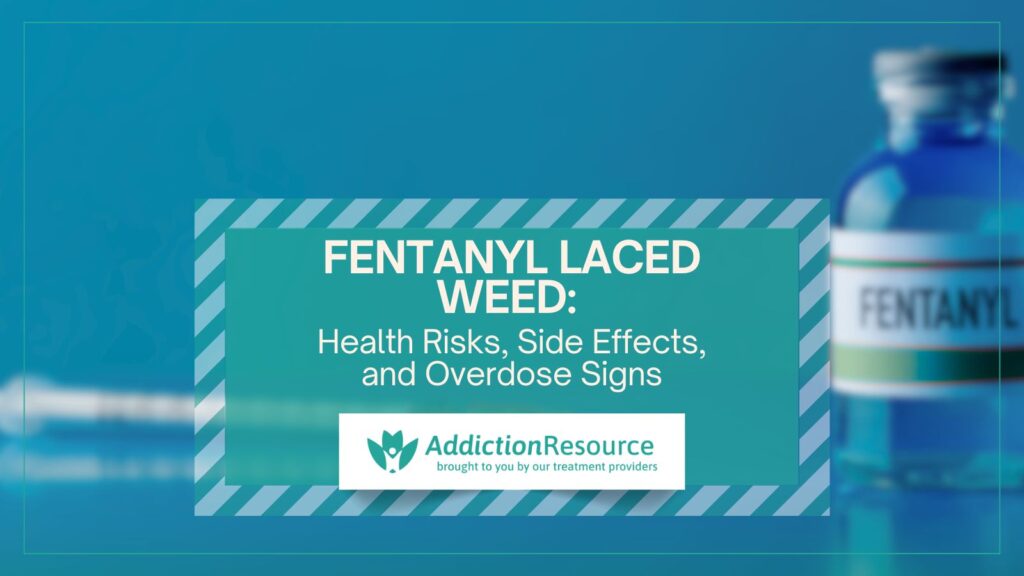
Fentanyl-laced weed refers to a dosage of marijuana that’s coated with a highly potent synthetic opioid called fentanyl. This mixture of two drugs has become highly dangerous and a growing concern due to the opioid crisis.
Fentanyl-laced weed is identified by looking for physical and visual signs, using fentanyl test strips, and checking for unusual odors.
The side effects of fentanyl-laced weed include the risk of marijuana or fentanyl addiction, stupor, changes in pupillary size, cold and clammy skin, blue discoloration of the skin, coma, respiratory failure leading to death, and risk of overdose.
Why is Marijuana (Weed) Laced with Fentanyl?
Marijuana (weed) is laced with fentanyl due to accidental contamination or intentional lacing by dealers. When fentanyl and marijuana are stored together, cross-contamination occurs during the packaging or transportation process which causes particles of fentanyl to mix with marijuana nearby.
Table Of Contents:
- Why is Marijuana (Weed) Laced with Fentanyl?
- What Does Fentanyl-Laced Weed Look Like?
- How Common is Fentanyl-Laced Weed?
- What are the Health Risks and Side Effects of Fentanyl-Laced Weed?
- How to Identify Fentanyl-Laced Weed?
- What to Do if Someone Has Used Fentanyl-Laced Weed?
- What are the Signs of Fentanyl Overdose?

In other cases, some dealers intentionally tamper with the marijuana and mix it with parts of fentanyl to make their buyers addicted to their product. The users become dependent on the synthetic effects of opioids without even knowing it, causing them to buy the product more.
What Does Fentanyl-Laced Weed Look Like?
Fentanyl-laced weed looks powdery and feels sticky. Fentanyl-laced weed has minor visual differences from regular marijuana which are hard to detect. Laced weed usually appears powdery and sticky and leaves a chemical-like residue whenever you touch it. It has a strange chemical or medicinal odor while normal marijuana has an earthy smell. The texture of fentanyl-laced weed feels slightly different due to the presence of fentanyl or other substances.
How Common is Fentanyl-Laced Weed?
Fentanyl-laced weed is currently uncommon. Even though the concerns are increasing, there are only a few officially reported cases of fentanyl-laced weed consumption in the United States. Even though verified cases of marijuana being laced with fentanyl are rare, many incidents have been reported in states like Vermont and New York which typically involve claims of fentanyl-contaminated marijuana leading to overdoses.
Fentanyl is a leading cause of drug overdoses in the United States, and some people who overdose do not know they are using fentanyl. However, as fentanyl remains more expensive than cannabis, fentanyl-laced cannabis would not make financial sense, according to a research titled: “What to know about fentanyl-laced cannabis” by Zawn Villines.
Synthetic fentanyl adulteration has become a significant threat to public safety. It is commonly mixed into other drugs of abuse to lower costs and increase its addictive potential. Diffuse alveolar hemorrhage (DAH) is a rare but life-threatening complication associated with the use of fentanyl-laced products. Given the current trend, we anticipate an increase in the incidence of DAH, according to a research titled: “A Rare Case of Diffuse Alveolar Hemorrhage Caused by Fentanyl-Laced Marijuana” by Quang Le.
What are the Health Risks and Side Effects of Fentanyl-Laced Weed?
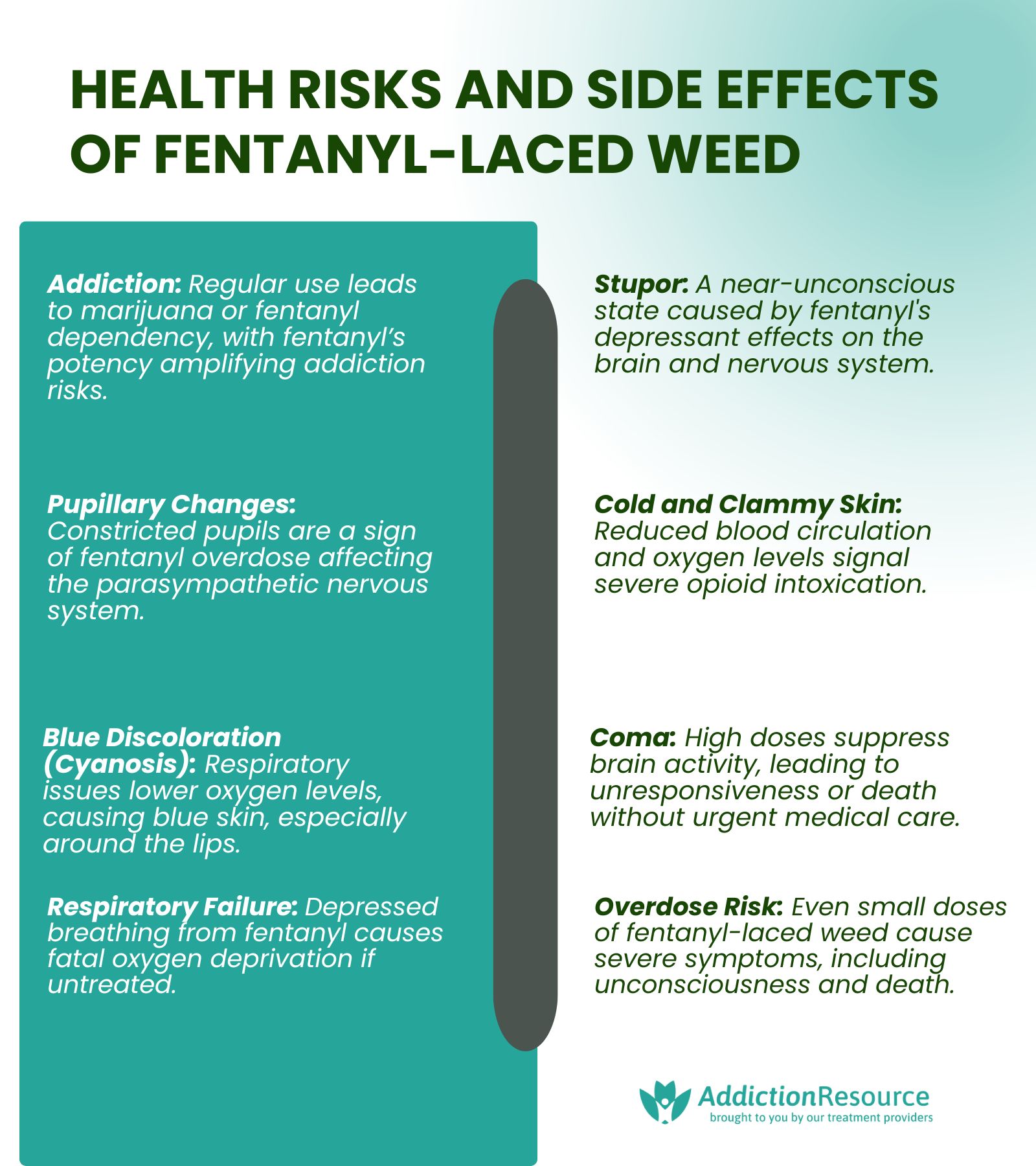
The health risks and side effects of fentanyl-laced weed are the risks of marijuana or fentanyl addiction, stupor, changes in pupillary size, cold and clammy skin, blue discoloration of the skin, coma, respiratory failure leading to death, and risk of overdose.
These health risks and side effects are described below.
- Risk of Marijuana or Fentanyl Addiction: The risk of Marijuana or fentanyl addiction rises from regular use of fentanyl-laced weed due to the development of dependencies. Marijuana is already highly addictive and fentanyl’s potent opioid properties and symptoms make the addiction even stronger.
- Stupor: Stupor refers to a state of near-unconsciousness or loss of alertness and is commonly caused due to fentanyl intoxication. The depressant side effects of fentanyl-laced weed impact the central nervous system, causing an individual’s brain to work slowly and impair their cognitive functions. Stupor is a major effect of fentanyl overdose, according to research titled: “Fentanyl” by the United States Drug Enforcement Administration (DEA).
- Changes in Pupillary Size: Changes in pupillary size occur when fentanyl-laced weed causes constricted pupils as it acts on the parasympathetic nervous system and is mainly caused due to overdose. Changes in pupil size are a major effect of fentanyl overdose, according to research titled: “Fentanyl” by the United States Drug Enforcement Administration (DEA).
- Cold and Clammy Skin: Cold and clammy skin is caused by reduced blood circulation and lack of oxygen in the body due to the consumption of fentanyl-laced weed. It is a signal of a sudden shock or a severe opioid intoxication and needs immediate medical attention.
- Blue Discoloration of the Skin: Blue discoloration of the skin or Cyanosis is caused by respiratory issues that lower the blood oxygen level due to fentanyl overdose. This bluish tint on the skin is more prominent around the lips and is a sign of a life-threatening emergency. Cyanosis is a common effect of fentanyl overdose, according to research titled: “Fentanyl” by the United States Drug Enforcement Administration (DEA).
- Coma: Coma is a state where an individual’s brain activity is severely suppressed and is caused due to high doses of fentanyl-laced weed. The individual is in an unresponsive state and this condition often causes death if immediate medical attention is not given. Inhaling the synthetic opioid fentanyl may cause potentially irreversible brain damage, according to a journal titled: “Fentanyl inhalation may cause potentially irreversible brain damage, warn doctors” by BMJ Case Reports.
- Respiratory Failure Leading to Death: Respiratory failure occurs when fentanyl-laced weed depresses the respiratory system and reduces the body’s ability to breathe properly. This condition leads to fatal oxygen deprivation if appropriate medical attention is not provided on time. Fentanyl produces more rapid depression of respiration than equipotent doses of heroin or morphine, according to a research titled: “Fentanyl depression of respiration: Comparison with heroin and morphine” by Rob Hill.
- Risk of Overdose: The risk of overdose is extremely high due to fentanyl’s potency which means even small amounts of fentanyl-laced weed cause major health issues. Common symptoms of overdose include unconsciousness, slow or stopped breathing, and potential death.
How to Identify Fentanyl-Laced Weed?
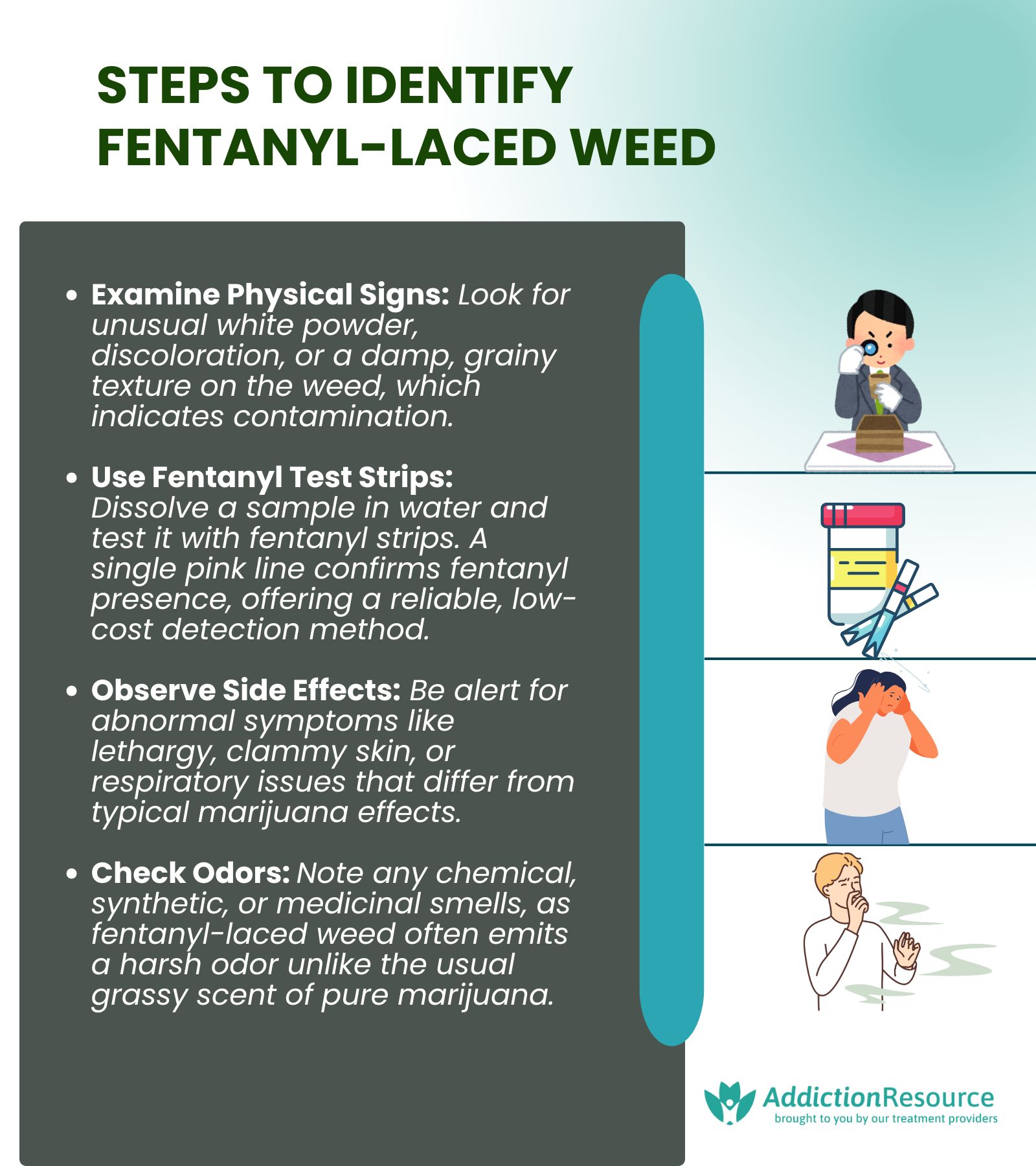
To identify fentanyl-laced weed, look for physical and visual signs, use fentanyl test strips, monitor side effects, and check for unusual odors.
These methods are described below.
- Look for Physical and Visual Signs: Look for physical and visual signs like unusual white or powdery residue or a weird discoloration on the marijuana. The texture of fentanyl-laced weed also feels damp or grainy, indicating some type of contamination.
- Use Fentanyl Test Strips: The use of fentanyl strips detects fentanyl by analyzing a dissolved sample of fentanyl-laced marijuana in water. If the strip shows one pink line, it indicates that samples of fentanyl are present in the weed. Fentanyl Testing Strips have higher specificity and sensitivity and are significantly less expensive than other methods, according to a research titled: “Perspectives on rapid fentanyl test strips as a harm reduction practice among young adults who use drugs: a qualitative study” by Jacqueline E. Goldman.
- Monitor Side Effects: Monitor unusual side effects that don’t occur from consuming regular weed including lethargy, dizziness, clammy skin, or respiratory distress. The effects of consuming fentanyl-laced weed are different than regular weed, so it is easy to deduce contamination after consumption.
- Check for Unusual Odors: Check for unusual odors like a chemical, medicinal, or synthetic smell emitted from the weed as these are signs of fentanyl contamination. Pure marijuana usually has a grassy smell. Fentanyl might alter this to a harsh chemical odor, like gasoline or nail polish, according to a research titled: “One Hit Could Be Your Last: Fentanyl-Laced Weed” by the Georgia Addiction Center.
What to Do if Someone Has Used Fentanyl-Laced Weed?
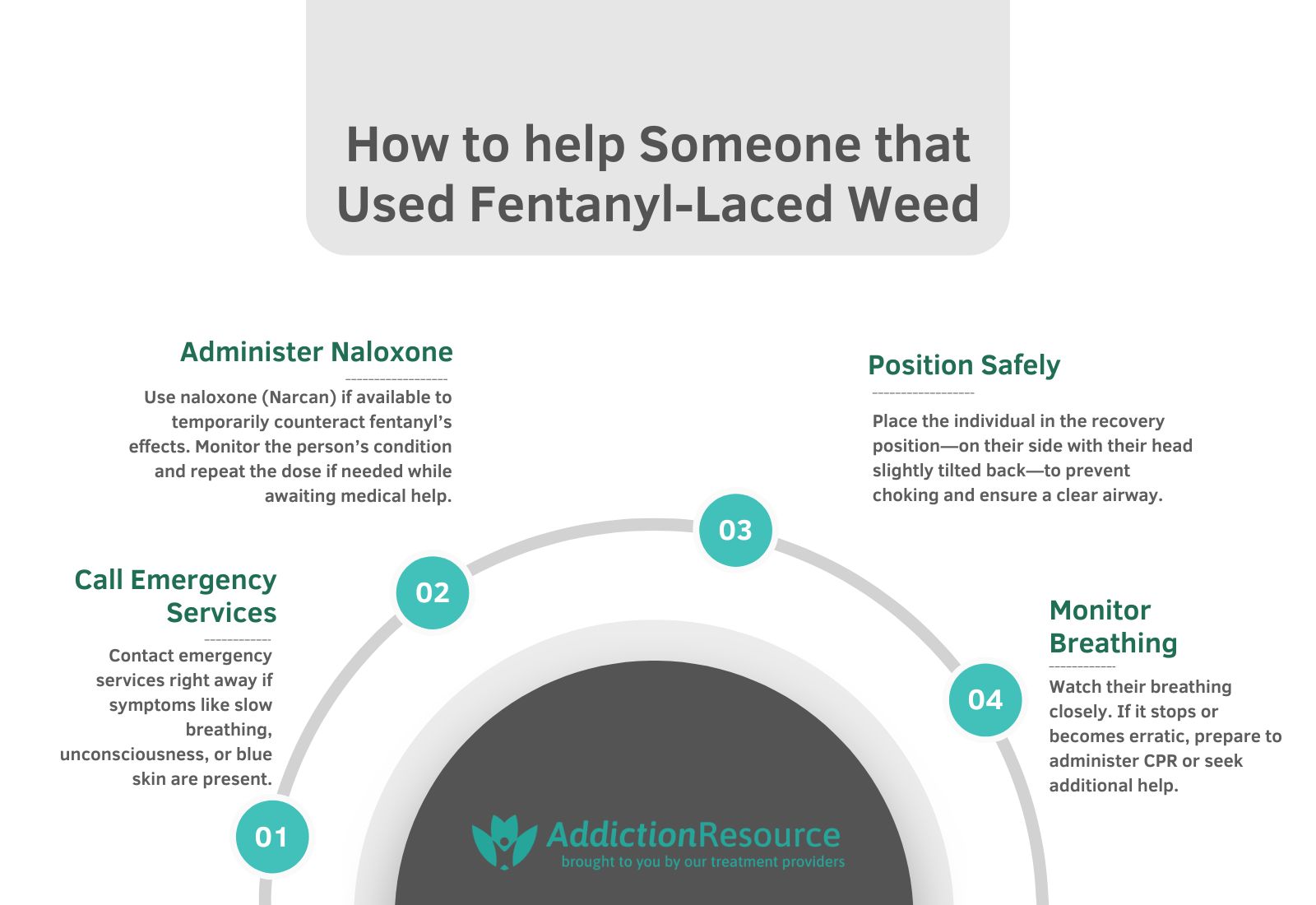
If someone has used fentanyl-laced weed, call emergency services, give them naloxone, position them safely, and monitor their breathing.
These steps are described below.
- Call Emergency Services: Call emergency services immediately if a person shows signs of fentanyl-laced weed consumption like slow breathing, loss of consciousness, or blue skin discoloration. Give the responders all the information and clear details until the paramedics arrive.
- Give Them Naloxone: Give them Naxolone (Narcan) immediately if it is available as this medication temporarily reverses the effects of fentanyl-laced weed, buying you critical time until the paramedics arrive for help. Monitor their condition and repeat the dose of Naxolone if required.
- Position Them Safely: Position them safely by placing the individual on the side of their head with their head slightly tilted backward. This is known as the recovery position and it prevents choking and maintains a clear airway to help with breathing, especially if they are unconscious.
- Monitor Their Breathing: Monitor their breathing pattern because if they stop breathing or show signs of respiratory distress, be prepared to perform CPR or seek help if people are nearby.
What are the Signs of Fentanyl Overdose?
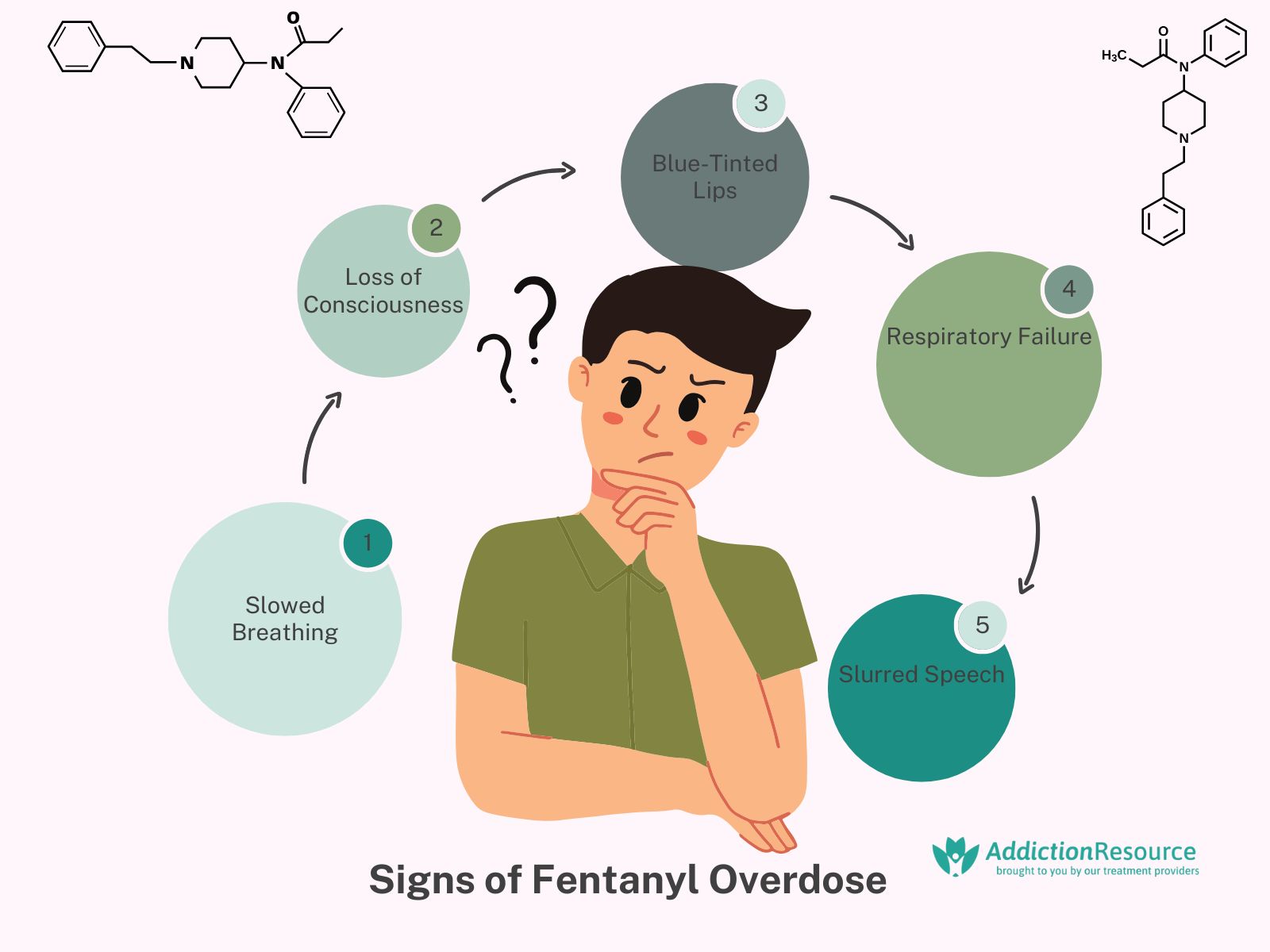
The signs of fentanyl overdose are slowed breathing, loss of consciousness, blue-tinted lips, respiratory failure, and slurred speech.
These signs are described below.
- Slowed Breathing: Slowed breathing occurs when fentanyl depresses the respiratory system which often leads to dangerously slow or irregular breathing. This deprives the brain and organs of oxygen and causes hypoxia which is a life-threatening condition.
- Loss of Consciousness: Loss of consciousness caused by fentanyl leads to an individual becoming unresponsive and they cannot gain consciousness even if you shake them or make loud noises. This is caused by suppression in the central nervous system due to overdose.
- Blue-Tinted Lips: Blue-tinted lips occur when breathing slows and the oxygen level in the body drops to dangerously low levels due to a fentanyl overdose. The lips and the rest of the face and fingertips may also turn blue.
- Respiratory Failure: Respiratory failure is a more severe case of fentanyl overdose where the person stops breathing completely. Respiratory failure leads to brain damage, organ failure, and ultimately death if not treated immediately with interventions like naloxone (Narcan) or professional medical help.
- Slurred Speech: Slurred speech occurs when fentanyl affects the brain’s ability to process signals which results in impaired coordination between the nerves. This symptom is sometimes an early warning sign of overdose as the drug suppresses motor skills and cognitive functions.
What is Fentanyl?
Fentanyl is a synthetic opioid medication used to treat severe pain, like the ones experienced during cancer treatment or after surgery. Fentanyl is significantly more potent than morphine, approximately 50 to 100 times stronger. Fentanyl is classified as a Schedule II controlled substance due to its high potential for abuse and addiction.
What is Weed?
Weed or marijuana refers to dried leaves, flowers, stems, and seeds of the cannabis plant. It contains compounds called cannabinoids, with the most notable being tetrahydrocannabinol (THC), which is responsible for its psychoactive effects.
How to Tell if Your Weed is Laced?
Laced weed shows physical or visual changes like unusual colors, a chemical or pungent odor, or an abnormal texture like being overly sticky or brittle. You can test it using fentanyl test strips or other drug-testing kits too.
Is Fentanyl-Laced Weed Dangerous?
Yes, fentanyl-laced weed is extremely dangerous. Fentanyl is 50 to 100 times stronger than morphine. Even a small amount of fentanyl causes severe respiratory depression, overdose, and death.
What is the Color of Fentanyl?
The color of fentanyl is powdery white in its pure form. Its appearance varies depending on how it is processed or mixed with other substances. Fentanyl is found in different forms, including powders of various colors when it is illegally manufactured.
What are the Other Names for Fentanyl-Laced Weed?
The other names for fentanyl-laced weed are laced weed, spiked cannabis, killer weed, tainted weed, Fetty weed, and poisoned pot.
What are the Other Drugs Laced with Marijuana (Weed)?
Other drugs laced with weed are cocaine, heroin, methamphetamine, LSD, and PCP. These substances are mixed to enhance the marijuana’s effects, but they increase the risk of dangerous side effects, addiction, and overdose.
Can Heroin be Laced with Marijuana?
Yes, heroin can be laced with marijuana. Heroin has potent sedative effects so it is often mixed with marijuana to intensify the sedative properties and alter the consumer’s experience.
What Does Being Laced Feel Like?
Being laced feels different from regular expected effects which causes unexpected reactions like sedation, heightened anxiety, hallucinations, or rapid heart rate. It also causes physical discomfort, confusion, or dangerous symptoms like difficulty breathing or unconsciousness
Hope Without Commitment
Find the best treatment options. Call our free and confidential helpline
Most private insurances accepted
Find Drug Rehabilitation Centers Near You Anywhere In the US
Addiction Resource team has compiled an extensive list of the top drug rehabilitation facilities around the country. Use our locator tool to find the best centers near you.


 Reviewed by:
Reviewed by: 
 FindTreatment.gov
FindTreatment.gov